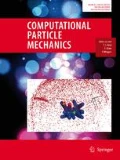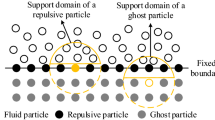Abstract
Problems of fluid–structure interaction with free-surface flow and multiple bodies are highly nonlinear phenomena, which is challenging for computational modeling and simulation. Particle-based methods have been proven to provide a substantial potential for simulation of free-surface fluid flows and their interactions with multiple solids that are often encountered in fluvial and coastal mechanics fields, due to their Lagrangian tracking scheme and meshless nature. When contact between solids occurs, a numerical modeling to detect it and prevent penetration between bodies is required to avoid numerical inconsistencies. The objective of this work is to propose a solid–solid contact model that relays on contact mechanics theories and, by an effective way to determine the normal direction of contact as well as the distance between bodies faces, eliminates the numerical instabilities induced by non-smooth modeling of bodies surfaces in the particle-based methods. The model adopts a penalty-based method that uses a nonlinear spring and dashpot concept, and thus reproducing the macroscopic properties of the multiple bodies interactions. To avoid very small time step for all the domain, a dynamic sub-cycling algorithm for rigid bodies contact is adopted. First, the present fluid solver, based on the moving particle semi-implicit method, is validated by hydrodynamic and fluid–structure interaction problems. Then, analytical and numerical results are compared, demonstrating the improvements achieved by the proposed model. Finally, the present model is validated via 3D dam breaking events, in which rigid bodies interact with each other or with fixed walls.





















Similar content being viewed by others
Abbreviations
- \( {\mathbf{a}} \) :
-
Acceleration vector
- \( C \) :
-
Courant number
- \( C_{\text{e}} \) :
-
Effective radius constant
- CM:
-
Center of mass
- \( c_{\text{n}} \) :
-
Normal damping constant
- \( c_{\text{t}} \) :
-
Tangential damping constant
- \( d \) :
-
Number of spatial dimensions
- \( {\text{d}}{\mathbf{a}} \) :
-
Body face area vector
- \( E \) :
-
Young’s modulus
- \( {\mathbf{f}} \) :
-
External body force per unit mass vector
- \( {\mathbf{f}}_{\text{c}} \) :
-
Contact force between rigid bodies vector
- \( {\mathbf{f}}^{\text{c}} \) :
-
Coulomb friction law force vector
- \( {\mathbf{f}}^{\text{d}} \) :
-
Damping force vector
- \( {\mathbf{f}}_{\text{ext}} \) :
-
External force on the rigid body vector
- \( {\mathbf{f}}_{\text{g}} \) :
-
Gravitational force vector
- \( {\mathbf{f}}_{\text{h}} \) :
-
Hydrodynamic force vector
- \( {\mathbf{f}}_{\text{n}} \) :
-
Normal component force vector
- \( {\mathbf{f}}^{\text{r}} \) :
-
Repulsion force vector
- \( {\mathbf{f}}_{\text{t}} \) :
-
Tangential component force vector
- \( {\mathbf{g}} \) :
-
Gravitational acceleration vector
- \( g \) :
-
Absolute value of gravitational acceleration
- \( H_{\text{w}} \) :
-
Water column height
- \( i,j \) :
-
Identification indexes of particles
- \( k,l \) :
-
Identification indexes of the closest particles that are in contact
- \( {\mathbf{I}} \) :
-
Inertia matrix
- \( k_{\text{n}} \) :
-
Normal stiffness constant
- \( k_{\text{t}} \) :
-
Tangential stiffness constant
- \( l_{0} \) :
-
Initial distance between two adjacent particles
- \( m \) :
-
Mass
- \( {\mathbf{M}} \) :
-
Moment vector due to hydrodynamic force
- \( {\mathbf{M}}_{\text{c}} \) :
-
Contact moment vector
- \( {\mathbf{M}}_{\text{ext}} \) :
-
External moment on the rigid body vector
- \( {\mathbf{n}}_{\text{c}} \) :
-
Contact normal vector
- \( {\mathbf{n}}_{i} \) :
-
Normal vector at wall particle i
- N :
-
Particle number density
- \( n^{0} \) :
-
Initial particle number density
- \( n^{*} \) :
-
Particle number density obtained in the explicit part of a time step
- N :
-
Number of particles
- \( \hat{N} \) :
-
Number of particles inside the limited search domain
- NB:
-
Number of bodies
- NBp :
-
Number of bodies in contact with the body p
- NC:
-
Number of pairs of particles belonging to two different bodies that are in contact
- P :
-
Pressure
- \( \hat{P} \) :
-
Minimum pressure of the neighborhood particles
- p, q :
-
Identification indexes of bodies
- Q :
-
Linear momentum
- r :
-
Position vector
- \( {\mathbf{r}}_{\text{c}} \) :
-
Position vector from the center of mass of the rigid body
- \( {\mathbf{r}}_{ci} \) :
-
Position vector between the center of mass of the rigid body and the wall particle i
- \( r_{\text{e}} \) :
-
Effective radius
- \( {\mathbf{r}}_{ij} \) :
-
Distance between two particles i and j
- \( {\bar{\mathbf{r}}}_{ij} \) :
-
Average distance between two particles i and j
- \( {\mathbf{r}}_{kl} \) :
-
Distance between pair of closest particles kl belonging to two different bodies
- \( {\mathbf{r}}_{ \bot } \) :
-
Distance of contact vector
- t :
-
Tangential contact vector
- t :
-
Time
- \( u_{\text{w}} \) :
-
Velocity of wave front
- u :
-
Velocity vector
- U :
-
Total energy
- U E :
-
Elastic energy
- \( U_{\text{K}} \) :
-
Kinetic energy
- α :
-
Artificial compressibility factor
- β :
-
Threshold value of PND for free surface particle detection
- γ :
-
Relaxation coefficient
- δ :
-
Overlap between two wall particles belonging to two different bodies
- \( \delta^{t} \) :
-
Tangential deformation
- \( \Delta t_{\text{f}} \) :
-
Time step used in the fluid domain
- \( \Delta t_{\text{s}} \) :
-
Time step used in the solid domain
- λ :
-
Correction parameter of the Laplacian model of the MPS method
- μ :
-
Kinetic friction coefficient
- \( \nu \) :
-
Poisson’s ratio
- \( \nu_{\text{k}} \) :
-
Kinematic viscosity
- \( \xi_{n} \) :
-
Collision ratio
- ρ :
-
Fluid density
- \( \varrho \) :
-
Weight free surface constant
- ϕ :
-
Scalar function
- ω :
-
Angular velocity vector
- ω :
-
Weight function
- Ω w :
-
Solid wall particles
References
Gingold RA, Monagham JJ (1977) Smoothed particle hydrodynamics: theory and application to non-spherical stars. Mon Not R Astron Soc 181:375–389
Lucy L (1977) A numerical approach to the testing of the fission hypothesis. Astron J 82:1013–1024
Koshizuka S, Oka Y (1996) Moving-particle semi-implicit method for fragmentation of incompressible fluid. Nucl Sci Eng 123(3):421–434
Harada T, Tanaka M, Koshizuka S, Kawaguchi Y (2007) Real-time coupling of fluids and rigid bodies. APCOM 07 in conjunction with EPMESC XI
Cundall PA, Strack ODL (1979) A discrete numerical model for granular assemblies. Geotechnique 29(1):47–65
Oh S, Kim Y, Roh BS (2009) Impulse-based rigid body interaction in SPH. Comput Anim Virtual Worlds 20:215–224
Amicarelli A, Albano R, Mirauda D, Agate G, Sole A, Guandalini R (2015) A smoothed particle hydrodynamics model for 3D solid body transport in free surface flows. Comput Fluids 116:205–228
Asai M, Chandra B (2016) Numerical prediction of bridge wash-out during natural disaster by using a stabilized ISPH method. In: The 2016 World Congress on Advances in Civil, Environmental, and Materials Research (ACEM16), Jeju island, Korea
Zhang S, Kuwabara S, Suzuki T, Kawano Y, Morita K, Fukuda K (2009) Simulation of solid–fluid mixture flow using moving particle methods. J Comput Phys 228:2552–2565
Ren B, Jin Z, Gao R, Wang YX, Xu ZL (2014) SPH-DEM modeling of the hydraulic stability of 2D blocks on a slope. J Waterw Port Coast Ocean Eng 140(6):1–12
Canelas RB, Crespo AJC, Domínguez JM, Ferreira RML (2016) SPH–DCDEM model for arbitrary geometries in free surface solid–fluid flows. Comput Phys Commun 202:131–140
Robb DM, Gaskin SJ, Marongiu JC (2016) SPH-DEM model for free-surface flows containing solids applied to river ice jams. J Hydraul Res 544(1):27–40
Tang Y, Jiang Q, Zhou C (2018) A Lagrangian-based SPH-DEM model for fluid–solid interaction with free surface flow in two dimensions. Appl Math Model 62:436–460
Tanaka M, Sakai M, Koshizuka S (2007) Particle-based rigid body simulation and coupling with fluid simulation. Trans Jpn Soc Comput Eng Sci, p. 20070007
Gotoh H, Ikari H, Yasuoka T (2009) Simulation of armor blocks in front of caisson breakwater by DEM-MPS hybrid model. In: The nineteenth international offshore and polar engineering conference
Harada E, Ikari H, Khayyer A, Gotoh H (2018) Numerical simulation for swash morphodynamics by DEM–MPS coupling model. Coast Eng J 61(1):2–14
Koshizuka S, Nobe A, Oka Y (1998) Numerical analysis of breaking waves using the moving particle semi-implicit method. Int J Numer Methods Fluids 26(7):751–769
Favier JF, Abbaspour-Fard MH, Kremmer M, Raji AO (1999) Shape representation of axi-symmetrical, non-spherical particles in discrete element simulation using multi-element model particles. Eng Comput 16(4):467–480
Chorin AJ (1967) The numerical solution of the Navier-Stokes equations for an incompressible fluid. Bull Am Math Soc 73(6):928–931
Tanaka M, Masunaga T (2010) Stabilization and smoothing of pressure in MPS method by quasi-compressibility. J Comput Phys 229(11):4279–4290
Ikeda H (1999) Numerical analysis of fragmentation processes in vapor explosion using particle method. Doctoral Thesis, Tokyo University, Japan. (in Japanese)
Gotoh H, Khayyer A, Ikari H, Arikawa T, Shimosako K (2014) On enhancement of Incompressible SPH method for simulation ofviolent sloshing flows. Appl Ocean Res 46:104–115
Lee BH, Park JC, Kim MH, Hwang SC (2011) Step-by-step improvement of MPS method in simulating violent free-surface motions and impact-loads. Comput Methods Appl Mech Eng 200(9–12):1113–1125
Wang L, Jiang Q, Zhang C (2017) Improvement of moving particle semi-implicit method for simulation of progressive water waves. Int J Numer Methods Fluids 85(2):69–89
Tsukamoto MM, Cheng LY, Motezuki FK (2016) Fluid interface detection technique based on neighborhood particles centroid deviation (NPCD) for particle methods. Int J Numer Methods Fluids 82(3):148–168
Quentrec B, Brot C (1975) New method for searching for neighbors in molecular dynamics computations. J Comput Phys 13(3):430–432
Courant R, Friedrichs K, Levy H (1967) On the partial difference equations of mathematical physics. IBM J Res Dev 11(2):215–234
Johnson KL (1985) Contact mechanics. Cambridge University Press, Cambridge
Kleefsman KMT, Fekken G, Veldman AEP, Iwanowski B, Buchner B (2005) A volume-of-fluid based simulation method for wave impact problems. J Comput Phys 206(1):363–393
Barcarolo DA (2013) Improvement of the precision and the efficiency of the SPH method: theoretical and numerical study. Ph.D. Thesis. Ecole Centrale de Nantes
Ritter A (1982) Die Fortpflanzung de Wasserwellen. Zeitschrift Verein Deutscher Ingenieure. 36:947–954
Vetsch D (2011) Numerical simulation of sediment transport with meshfree methods. Ph.D. thesis. ETH Zurich
Shakibaeinia A, Jin YC (2012) MPS mesh-free particle method for multiphase flows. Comput Methods Appl Mech Eng 229–232:13–26
Hoomans B (2000) Granular dynamics of gas-solid two-phase flows. PhD. Thesis. University of Twente
Lc Qiu, Jin F, Pz Lin, Liu Y, Han Y (2017) Numerical simulation of submarine landslide tsunamis using particle based methods. J Hydrodyn 29(4):542–551
Rastgoftar E, Jannat MRA, Banijamali B (2018) An integrated numerical method for simulation of drifted objects trajectory under real-world tsunami waves. Appl Ocean Res 73:1–16
Ahrens J, Geveci B, Law C (2005) ParaView: an end-user tool for large data visualization, visualization handbook. Elsevier, Amsterdam
SideFX. Houdini. [Internet]. 2018 Available from: https://www.sidefx.com/
Acknowledgements
This study was financed in part by the Coordenação de Aperfeiçoamento de Pessoal de Nível Superior - Brasil (CAPES) - Finance Code 001, and by FDTE. The authors are also grateful to Petrobras for financial support on the development of the MPS/TPN-USP simulation system based on MPS method. The authors would also like to thank D.Sc. Ricardo Birjukovs Canelas for the schematic drawing of the experimental configuration.
Author information
Authors and Affiliations
Corresponding author
Additional information
Publisher’s Note
Springer Nature remains neutral with regard to jurisdictional claims in published maps and institutional affiliations.
Rights and permissions
About this article
Cite this article
Amaro Junior, R.A., Cheng, LY. & Osello, P.H.S. An improvement of rigid bodies contact for particle-based non-smooth walls modeling. Comp. Part. Mech. 6, 561–580 (2019). https://doi.org/10.1007/s40571-019-00233-4
Received:
Revised:
Accepted:
Published:
Issue Date:
DOI: https://doi.org/10.1007/s40571-019-00233-4




